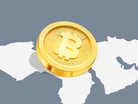Will MENA beat 2022's record for cryptocurrency adoption?

MENA has emerged as one of the world’s biggest cryptocurrency markets in the past few years. Between 2021 and 2022, crypto transactions in the region increased by 48%; today, it accounts for 9.2% of global cryptocurrency transactions, according to Chainalysis.
This large-scale crypto adoption has been driven by the region’s DeFi and blockchain-friendly economic climate. Compared to other areas, MENA countries impose less regulatory scrutiny, promoting wider adoption of a decentralised digital economy.
The question is, will this growth continue throughout the next quarters of 2023 — and how will the crypto market evolve further in this region?
Why is MENA continuing to lead in cryptocurrency adoption?
The biggest reason for crypto to thrive in these countries is that almost 55% of the region’s population is below the age of 30. Younger and more tech-savvy people are more eager to embrace technological and financial innovations, including cryptocurrencies.
Second, the MENA region is going through a social and economic revolution: many of its countries suffer from inequitable income distribution and high youth unemployment levels. Therefore, the population is seeking alternative financial instruments.
And third, there’s a growing awareness of blockchain and decentralised technology in the region. Eager to gain an advantage over the Western markets and strengthen their economic positions, businesses and the government are exploring the benefits of blockchain to streamline processes, increase transparency, and reduce costs.
Which MENA countries are leading the crypto market in 2023?
According to Chainalysis’ 2022 Global Crypto Adoption Index, three MENA countries were among the top 30 regions by adoption rate: Turkey (12th), Morocco (14th), and Egypt (24th).
Turkey has seen a continuous shift towards increasing crypto adoption. In January 2023, The Nation Alliance, the leading political opposition party, released its election doctrine with 13 points directly aimed at increasing crypto adoption. So should Turkey’s political power change, it may further boost the country’s already booming cryptocurrency adoption.
In Morocco, the central bank (Bank Al-Maghrib) is drafting a crypto law to protect individuals from trading risks. This regulatory framework will further enhance adoption in the country, as Moroccans will have the national bank’s support.
Another region worth mentioning is Dubai, which is steadily transforming into a crypto hub. In addition to new startups, industry giants such as Crypto.com are moving their operations hubs to Dubai to benefit from its favourable tax policies and regulations. Local projects, like Islamic Coin, are using the tech to bring inclusion to the Muslim population by creating Shariah-compliant, accessible financial tools.
What factors are driving the industry’s growth?
The latest projections show that the global crypto market will have a compound annual growth (CAGR) of 11.9% in the next seven years. This will take the market value, which currently sits at US$4.7bn, to $12.1bn by 2030.
As the market’s growth is more prominent in the MENA region, this global growth will evidently boost the region’s market value. The Gulf countries, particularly, have shown eager interest in welcoming crypto and blockchain entrepreneurs.
For instance, in the UAE, investors and business owners enjoy 0% tax on cryptocurrency profits; other leading countries in the region such as Turkey also do not impose any taxation on cryptocurrency profits. As a result, there were over 3,000 new crypto, blockchain, and digital assets startups registered in the country in the last year alone.
The DMCC free trade zone in the UAE will further influence more startups and existing companies to shift their businesses to the region. Gartner forecasts predict that the overall IT spending of the region will grow by at least 3% in 2023, which means more investments will go toward evolving digital asset technologies like blockchain and using them to solve current issues.
In conclusion, MENA countries will remain the leading market for the digital assets industry. As regulators embrace the concept of a fully digital and decentralised economy, more blockchain and crypto-based businesses will shift to the region, allowing the market to grow further in 2023 and beyond.
About the author
Mohammed AlKaff AlHashmi is Co-Founder of Islamic Coin, a mega-blockchain project that claims to be the world’s first Shariah-compliant cryptocurrency. He has over 18 years of experience in Computer Science & Engineering with a focus on Industry 4.0, artificial intelligence, machine learning, industrial automation, and IoT.

